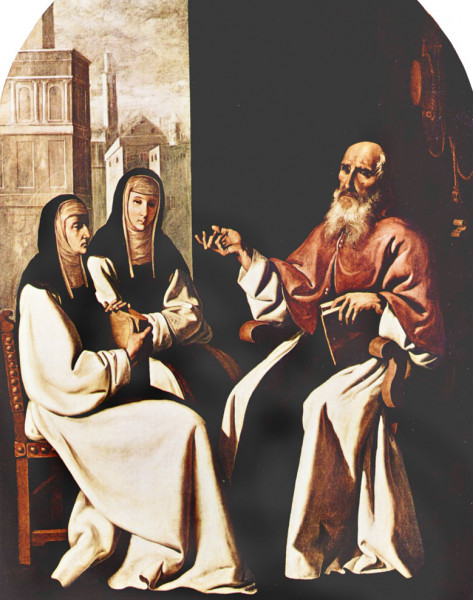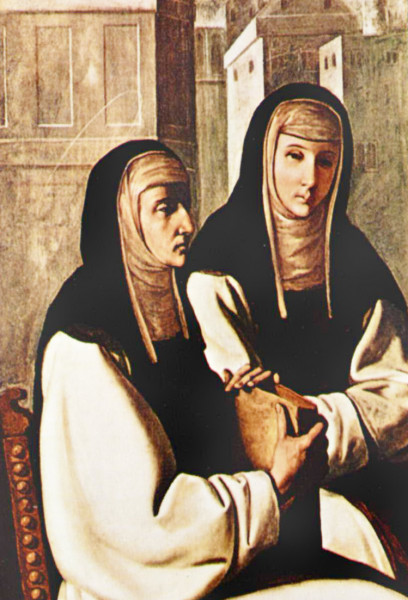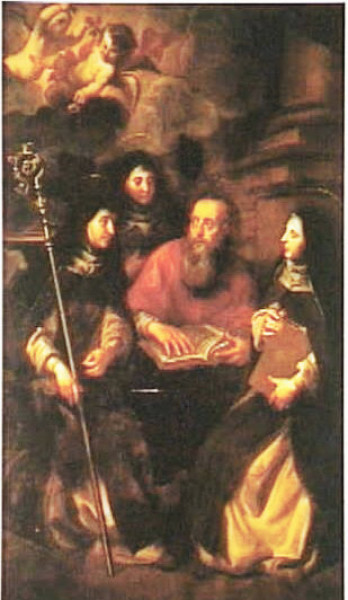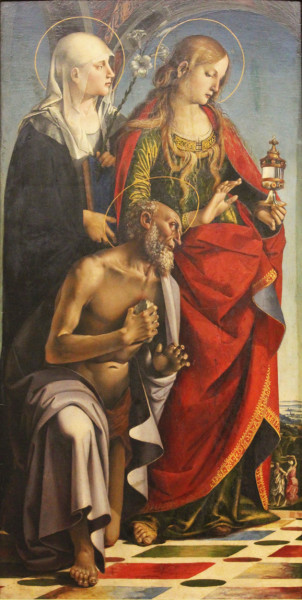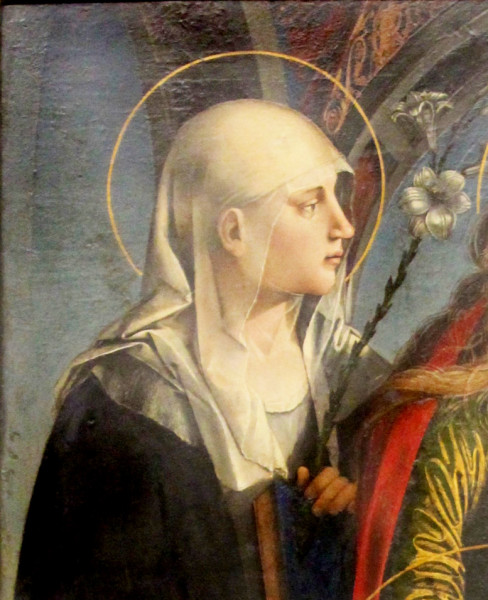At the end of the IV century, Christianity was already rather deeply rooted in Roman society. In 382 Emperor Gratian gave up his title of Pontifex Maximus (the greatest priest, guardian of all religions), a title which had for centuries been reserved for the emperors and became simply the guardian of Christians. Roman aristocrats still practiced their traditional pagan cults, but many of them began giving into Christianity. Some did so for private gain (they recognized that the time was right), others because they were truly fascinated by the new faith. Among these, women made up a significant number, as for them belief in Christ and being close to the Holy Scriptures were a source of intense, nearly obsessive experiences. One of these was Paula Asinia. She came from a family whose roots stretched all the way to the Roman Republic, and initially led a normal, luxurious life, typical for someone of her status: "dressed in silk and carried around by eunuchs” – this is how Jerome described Paula in a posthumous letter (Letter 108) sent to her daughter Eustochium. It is from this letter that other quotations, as well as rather scant information about this extraordinary woman, come from.
At about fifteen years old she married the senator Julius Toxotius, later giving birth to five children – daughters Blaesilla, Paulina, Eustochium, and Rufina, as well as a son Toxotius. We do not know when exactly she converted to Christianity but it had to be when her husband still lived, who while himself, not a Christian accepted the religious choice of his wife. Paula's and Toxotius's home was located near the Church of San Girolamo della Carità between the via di Monserrato and Piazza Santa Caterina della Rota.
Toxotius's death in 379 resulted (or allowed) the then thirty-two-year-old widow to devote herself to religious life, in which she was greatly supported by another pious aristocrat – Marcella. In her villa on Aventine Hill, a group of educated, fluent in Greek women gathered, who read the Bible out loud, interpreted its fragments, prayed together, and grew strong in their faith. This “Bible study group” of sorts, in the year 382 added a future saint and a Doctor of the Church, Jerome, who after a long journey came to Rome and occupied himself with the translation of the Bible into Latin (Vulgate), entrusted to him by the then Bishop of Rome Damasus I. In Marcella’s group Jerome found grateful and intelligent students, who talked with him about problems of biblical exegesis, and devotedly listened to his commentary on the translated verses of the Scriptures, as well as his praise of celibacy, virginity, and asceticism. Biblical studies occupied Paula to such a degree, that along with her daughter Eustochium she began learning Hebrew.
Paula welcomed the lonely and difficult to get along with Jerome into her house, caring for him and befriending him. He, on the other hand, recalling those moments wrote about her: “sad, fasting, covered with a dark dress, nearly blind from crying, whom the sun saw after a whole night of prayers, form whom Psalms were a song, the Gospel was speech, and restraint was a delight”. Most likely the reason for Paula’s condition was not only religious ecstasy but also the unexpected death of her oldest daughter Blaesilla.
Until Jerome’s patron, Pope Damasus was alive, his position in Rome was rather stable, although there were rumors about criticism regarding his contacts with the aforementioned women. After the pope's death (384) Jerome was forced to leave the city. There were several reasons for this, and three of them were connected with Paula and her family. The asceticism, profound devotion, as well as the planned abandoning of her family and removal from public life, were widely commented on and criticized in Rome since she represented a way of life that while not exactly new among the Roman aristocracy, was still rather seldom practiced. The aristocratic circles erupted, especially after, her daughter, Eustochium decided to remain a virgin. And it was not only pagans who were furious; Christians themselves also criticized such practices, staunchly rejecting Jerome’s rigorous teachings, especially canonic virginity which he highly praised. The tensions grew when after an exhausting starvation diet Blaesilla died. There were those in the city who blamed Jerome and who spoke of his depraving influence on mature women, but most of all Roman girls, whom he convinced to remain unmarried (virginity), as well as inhuman asceticism.
Jerome left Rome in 385, and a few weeks later Paula and Eustochium followed suit, along with a few other people. Jerome praised Paula, because despite the tears and requests of her children she had decided to abandon them. “overcoming her love for her children by her greater love for God," – he wrote. Initially, they followed the trail set out by Christ himself – they visited Palestine, Syria, and Egypt, followed by a visit to the eremites living in a desert in Syria, and then Melania the Elder, an aristocrat from Rome who had already left the city. They gathered experience regarding the ascetic community which they desired to establish. This ultimately came to pass near Bethlehem – it is there, thanks to Paula’s finances that they built a type of a monastery for men, who were supervised by Jerome, and for women, led by Paula. She divided the women into three groups, based on the social rank (!) they represented and she introduced a principle of mortification of the flesh and spirit, which she herself had practiced. Her asceticism concerned not only meals, but also personal hygiene (“She never entered a bath except when dangerously ill”), since – as she claimed, and Jerome supported her – “a clean body and a clean dress mean an unclean soul.” Jerome had praised her virtues multiple times – humility, modesty, and a Spartan way of life. “Even in the severest fever she rested not on an ordinary bed but on the hard ground covered only with a mat of goat's hair" – he wrote. He emphasized her fasting, rejection of wine, shabby clothes, and wearing sackcloth, but also her piousness which resulted from studying the Bible, and patience in teaching women, whom she cared for, which was most likely quite a challenge. She introduced her charges to the principles of asceticism, solved both their mental problems and religious dilemmas. Let us not forget, that at that time all of this was new, while the principles of life in the monastery were in their nascent stage. Paula’s tasks also included maintaining the uneasy relations with the local clergy, including the Bishop of Jerusalem, John, who looked with disfavor upon the difficult to control and remaining outside his authority monastic oases – since more than once these communes were filled with behavior, which we would presently classify as a sect.

Paula and Eustochium were also tasked with creating the appropriate conditions for Jerome to work on his translation of the Old Testament, which he devoted himself to in Bethlehem. Meanwhile, the news from Rome was not good for Paula. Two of her daughters, Rufina and Paulina had died there. She received some consolation when her granddaughter (Paula II) joined the commune, helped her in her work, while after her grandmother’s death, along with her aunt Eustochium she led the monastery and cared for Jerome. In time financial problems appeared. Therefore, they built a shelter for pilgrims, to obtain the necessary means to maintain the commune.
Paula died at the age of 57. She was buried in a grotto not far from the Basilica of the Nativity in Bethlehem. In a letter devoted to her, Jerome wrote, that her life was a kind of martyrdom that predestined her for sainthood. In his opinion she also possessed an excellent womanly virtue: "she was not keen on talking, but willing to listen”. The Church Doctor, however, could not stop himself and at the end pointed out her lack of sense of prediction: "Jesus is witness that Paula has left not a single penny to her daughter but, as I said before, on the contrary, a large mass of debt; and, worse even than this, a crowd of brothers and sisters whom it is hard for her to support but whom it would be undutiful to cast off.” This sounds like a complaint against a woman who stopped providing him with the peace which was necessary for work and passed on too quickly, leaving him with problems.
Paula can be considered the personification of all the nameless nuns, whose life for centuries has been filled with service and silence. And although Jerome compared her life to true martyrdom, her cult is marginal, in the same way that the role of nuns is marginalized in the Church. In art, she was immortalized rather sporadically and only in the company of Saint Jerome, sometimes along with Saint Eustochium.
The only Roman church dedicated to her was not built until 1951 (Santa Paola Romana) in the Trionfale district on the outskirts of the city.

